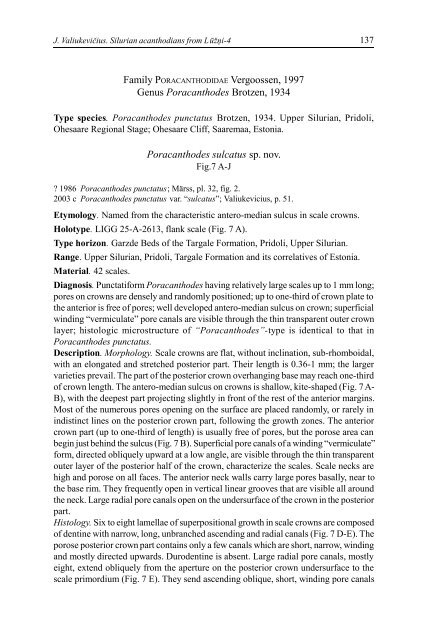Zemes un vides zinātnes Earth and Environment Sciences - Latvijas ...
Zemes un vides zinātnes Earth and Environment Sciences - Latvijas ...
Zemes un vides zinātnes Earth and Environment Sciences - Latvijas ...
Create successful ePaper yourself
Turn your PDF publications into a flip-book with our unique Google optimized e-Paper software.
J. Valiukevičius. Silurian acanthodians from Lūžņi-4<br />
137<br />
Family PORACANTHODIDAE Vergoossen, 1997<br />
Genus Poracanthodes Brotzen, 1934<br />
Type species. Poracanthodes p<strong>un</strong>ctatus Brotzen, 1934. Upper Silurian, Pridoli,<br />
Ohesaare Regional Stage; Ohesaare Cliff, Saaremaa, Estonia.<br />
Poracanthodes sulcatus sp. nov.<br />
Fig.7 A-J<br />
? 1986 Poracanthodes p<strong>un</strong>ctatus; Märss, pl. 32, fig. 2.<br />
2003 c Poracanthodes p<strong>un</strong>ctatus var. “sulcatus”; Valiukevicius, p. 51.<br />
Etymology. Named from the characteristic antero-median sulcus in scale crowns.<br />
Holotype. LIGG 25-A-2613, flank scale (Fig. 7 A).<br />
Type horizon. Garzde Beds of the Targale Formation, Pridoli, Upper Silurian.<br />
Range. Upper Silurian, Pridoli, Targale Formation <strong>and</strong> its correlatives of Estonia.<br />
Material. 42 scales.<br />
Diagnosis. P<strong>un</strong>ctatiform Poracanthodes having relatively large scales up to 1 mm long;<br />
pores on crowns are densely <strong>and</strong> r<strong>and</strong>omly positioned; up to one-third of crown plate to<br />
the anterior is free of pores; well developed antero-median sulcus on crown; superficial<br />
winding “vermiculate” pore canals are visible through the thin transparent outer crown<br />
layer; histologic microstructure of “Poracanthodes”-type is identical to that in<br />
Poracanthodes p<strong>un</strong>ctatus.<br />
Description. Morphology. Scale crowns are flat, without inclination, sub-rhomboidal,<br />
with an elongated <strong>and</strong> stretched posterior part. Their length is 0.36-1 mm; the larger<br />
varieties prevail. The part of the posterior crown overhanging base may reach one-third<br />
of crown length. The antero-median sulcus on crowns is shallow, kite-shaped (Fig. 7 A-<br />
B), with the deepest part projecting slightly in front of the rest of the anterior margins.<br />
Most of the numerous pores opening on the surface are placed r<strong>and</strong>omly, or rarely in<br />
indistinct lines on the posterior crown part, following the growth zones. The anterior<br />
crown part (up to one-third of length) is usually free of pores, but the porose area can<br />
begin just behind the sulcus (Fig. 7 B). Superficial pore canals of a winding “vermiculate”<br />
form, directed obliquely upward at a low angle, are visible through the thin transparent<br />
outer layer of the posterior half of the crown, characterize the scales. Scale necks are<br />
high <strong>and</strong> porose on all faces. The anterior neck walls carry large pores basally, near to<br />
the base rim. They frequently open in vertical linear grooves that are visible all aro<strong>un</strong>d<br />
the neck. Large radial pore canals open on the <strong>un</strong>dersurface of the crown in the posterior<br />
part.<br />
Histology. Six to eight lamellae of superpositional growth in scale crowns are composed<br />
of dentine with narrow, long, <strong>un</strong>branched ascending <strong>and</strong> radial canals (Fig. 7 D-E). The<br />
porose posterior crown part contains only a few canals which are short, narrow, winding<br />
<strong>and</strong> mostly directed upwards. Durodentine is absent. Large radial pore canals, mostly<br />
eight, extend obliquely from the aperture on the posterior crown <strong>un</strong>dersurface to the<br />
scale primordium (Fig. 7 E). They send ascending oblique, short, winding pore canals
















